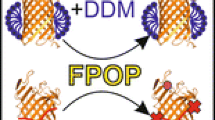Abstract
Loss of stability and integrity of large membrane protein complexes as well as their aggregation in a non-lipidic environment are the major bottlenecks to their structural studies. We have tested C12H25-S-poly-Tris-(hydroxymethyl)acrylamidomethane (H12-TAC) among many other detergents for extracting the yeast F1F0 ATP-synthase. H12-TAC was found to be a very efficient detergent for removing the enzyme from mitochondrial membranes without altering its sensitivity towards specific ATP-synthase inhibitors. This extracted enzyme was then solubilized by either dodecyl maltoside (DDM), H12-TAC or fluorinated surfactants such as C2H5-C6F12-C2H4-S-poly-Tris-(hydroxymethyl)acrylamidomethane (H2F6-TAC) or C6F13-C2H4-S-poly-Tris-(hydroxymethyl)acrylamidomethane (F6-TAC), two surfactants exhibiting a comparable polar head to H12-TAC but bearing a fluorinated hydrophobic tail. Preparations from enzymes purified in the presence of H12-TAC were found to be more adapted for AFM imaging than ATP-synthase purified with DDM. Keeping H12-TAC during the Ni-NTA IMAC purification step or replacing it by DDM at low concentrations did not however allow preserving enzyme activity, while fluorinated surfactants H2F6-TAC and F6-TAC were found to enhance enzyme stability and integrity as indicated by sensitivity towards inhibitors. ATPase specific activity was higher with F6-TAC than with H2F6-TAC. When enzymes were mixed with egg phosphatidylcholine, ATP-synthases purified in the presence of H2F6-TAC or F6-TAC were more stable upon time than the DDM purified enzyme. Furthermore, in the presence of lipids, an activation of ATP-synthases was observed that was transitory for enzymes purified with DDM, but lasted for weeks for ATP-synthases isolated in the presence of molecules with Tris polyalcoholic moieties. Relipidated enzymes prepared with fluorinated surfactants remained highly sensitive towards inhibitors, even after 6 weeks.
Similar content being viewed by others
References
Abla M, Durand G, Pucci B (2008) J. Org. Chem. 73:8142–8153
Arnold I, Pfeiffer K, Neupert W, Stuart RA, Schägger H (1998) EMBO J. 17:7170–7178
Arselin G, Giraud M-F, Dautant A, Vaillier J, Brèthes D, Coulary-Salin B, Schaeffer J, Velours J (2003) Eur. J. Biochem. 270:1875–1884
Barthélémy P, Ameduri B, Chabaud E, Popot J-L, Pucci B (1999) Org. Lett. 1:1689–1692
Bowie JU (2001) Curr. Opin. Struct. Biol. 11:397–402
Breyton C, Chabaud E, Chaudier Y, Pucci B, Popot J (2004) FEBS Lett. 564:312–318
Chabaud E, Barthélémy P, Mora N, Popot JL, Pucci B (1998) Biochimie. 80:515–530
Chen C, Ko Y, Delannoy M, Ludtke SJ, Chiu W, Pedersen PL (2004) J. Biol. Chem. 279:31761–31768
Dauvergne J, Polidori A, Vénien-Bryan C, Pucci B (2008) Tet. Lett. 49:2247–2250
Dickson VK, Silvester JA, Fearnley IM, Leslie AGW, Walker JE (2006) EMBO J. 25:2911–2918
Dubourg F, Aimé J-P, Marsaudon S, Couturier G, Boisgard R (2003) J. Phys. Condens. Matter. 15:6167–6177
Garavito RM, Ferguson-Miller S (2001) J. Biol. Chem. 276:32403–32406
Grandier-Vazeille X, Guérin M (1996) Anal. Biochem. 242:248–254
Guérin B, Labbe P, Somlo M (1979) Methods Enzymol. 55:149–159
Hunte C, Von Jagow G, Schagger H (2003) Membrane protein purification and crystallization. Academic, London
Kabaleeswaran V, Puri N, Walker JE, Leslie AGW, Mueller DM (2006) EMBO J. 25:5433–5442
Kabaleeswaran V, Shen H, Symersky J, Walker J, Leslie AW, Mueller D (2009) J. Biol. Chem. 284:10546–10551
Ko YH, Delannoy M, Hullihen J, Chiu W, Pedersen PL (2003) J. Biol. Chem. 278:12305–12309
Krafft MP (2001) Adv. Drug. Deliv. Rev. 47:209–228
Lebaupain F, Salvay AG, Olivier B, Durand G, Fabiano A, Michel N, Popot J-L, Ebel C, Breyton C, Pucci B (2006) Langmuir 22:8881–8890
Lowry OH, Rosebrough NJ, Farr AL, Randall RJ (1951) J. Biol. Chem. 193:265–275
Lévy D, Mosser G, Lambert O, Moeck GS, Bald D, Rigaud J-L (1999) J. Struct. Biol. 127:44–52
Maali A, Hurth C, Boisgard R, Jai C, Cohen-Bouhacina T, Aimé J-P (2005) J. Appl. Phys. 97:74907.1–74907.6
MacLennan DH, Smoly JM, Tzagoloff A (1968) J. Biol. Chem. 243:1589–1597
Myrtil E, Zarif L, Greiner J, Riess JG, Pucci B, Pavia AA (1995) J. Fluorine Chem. 71:101–105
Neff D, Tripathi S, Middendorf K, Stahlberg H, Butt H, Bamberg E, Dencher N (1997) J. Struct. Biol. 119:139–148
Park K, Berrier C, Lebaupain F, Pucci B, Popot J-L, Ghazi A, Zito F (2007) Biochem J. 403:183–187
Pavia AA, Pucci B, Riess JG, Zarif L (1991) Bioorg. Med. Chem. Lett. 1:103–106
Posokhov YO, Rodnin MV, Das SK, Pucci B, Ladokhin AS (2008) Biophys J. 95:L54–L56
Privé GG (2007) Methods. 41:388–397
Pucci B, Maurizis J, Pavia A (1991) Eur. J. Polym. 27:1101–1106
Pucci B, Maurizis J, Pavia A (1993) BioOrg. Med. Chem. Lett. 3:161–164
Rodnin MV, Posokhov YO, Contino-Pépin C, Brettmann J, Kyrychenko A, Palchevskyy SS, Pucci B, Ladokhin AS (2008) Biophys J. 94:4348–4357
Rubinstein JL, Walker JE, Henderson R (2003) EMBO J. 22:6182–6192
Schabert FA, Engel A (1994) Biophys. J. 67:2394–2403
Schägger H, Pfeiffer K (2000) EMBO J. 19:1777–1783
Schägger H, Cramer WA, von Jagow G (1994) Anal. Biochem. 217:220–230
Singleton WS, Gray MS, Brown ML, White JL (1965) J. Am. Oil. Chem. Soc. 42:53–56
Somlo M (1968) Eur. J. Biochem. 5:276–284
Stock D, Leslie AG, Walker JE (1999) Science. 286:1700–1705
Tietz A, Ochoa S (1958) Arch. Biochem. Biophys. 78:477–493
Velours J, Arselin G (2000) J. Bioenerg. Biomembr. 32:383–390
Author information
Authors and Affiliations
Corresponding author
Rights and permissions
About this article
Cite this article
Talbot, JC., Dautant, A., Polidori, A. et al. Hydrogenated and fluorinated surfactants derived from Tris(hydroxymethyl)-acrylamidomethane allow the purification of a highly active yeast F1-F0 ATP-synthase with an enhanced stability. J Bioenerg Biomembr 41, 349–360 (2009). https://doi.org/10.1007/s10863-009-9235-5
Received:
Accepted:
Published:
Issue Date:
DOI: https://doi.org/10.1007/s10863-009-9235-5




